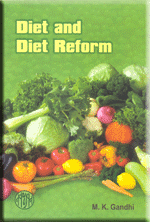
P.O. SEVAGRAM, DIST.WARDHA 442102, MS, INDIA. Phone: 91-7152-284753
FOUNDED BY MAHATMA GANDHI IN 1936
DIET AND DIET REFORM

DIET AND DIET REFORM
Table of Contents
PART-I
- SECTION I: General
- My Faith In Vegetarianism
- The Moral Basis of Vegetarianism
- Diet For Brahmacharya
- Green and Dietetic Ahimsa
- 'Food Faddists'
- Unfired Food Experiment
- Unfired Food
- Unfired Food
- Unfired Food
- National Food
- Minimum Diet
- For Four Rupees A Month
- A Talk to Village Workers
- Minimum Diet
- Plea for More Fruits
- Carrion-eating
- SECTION II : Rice, Wheat and Gur
- SECTION III : Soya Beans and Ground-nuts
- SECTION IV : Green Leaves, etc.
- SECTION V : Milk
- SECTION VI : Ghee and Oil
PART-II
- SECTION I : General
- Precautions Against Ills of The Season (M.D.)
- Dietetic Changes (M.D.)
- Mortification of The Flesh (M.D.)
- Vitamins - I (P. C. Ghosh)
- Vitamins - II (P. C. Ghosh)
- Physiological Basis of Nutrition
- Are you acid? (H. C. Menkel)
- What And How Much To Eat? (H. C. Menkel)
- Question on Diet (H. C. Menkel)
- Improved Diets (A. K.)
- Place of Cereals in Food (I. Amin)
- An Experiment in National Diet (Pyarelal)
- Revealing Figures (A. K.)
- SECTION II : Rice, Wheat and Gur
- The Miracle of Unpolished Rice (M.D.)
- Unpolished v. Polished Rice (Prof. Basu)
- Saving Cereals (D. K. Gupta)
- Useful Suggestion (M. A. Chadray)
- White v. Brown Sugar (M. D.)
- The Havoc of Sugar (M. D.)
- Bad Teeth and Refined Carbohydrates
- Potentialities of Palm Jaggery (Gajanan Naik)
- Nira - A Nutritious Beverage (Gajanan Naik)
- SECTION III : Soya Beans and Ground-nuts
- Warning against Soya Beans (M. D.)
- Soya Beans (M.D.)
- Soya Bean Recipes
- A Soya Bean Book (M. D.)
- The Utility of The Ground-nut (A. K.)
- SECTION IV : Fruit
- The Merit of Amla (A. K.)
- SECTION V : Milks
- Kimmed Milk and Buttermilk (W. R. Aykroyd and S. C. Dasgupta)
- SECTION VI : Ghee And Oil
- Edible Oils (P. C. Ghosh)
- Blindness At A Price (J. C. Kumarappa)
- Nakali Ghee (J. C. Kumarappa)
- SECTION VII : Tea
- Another Rising Menance (J. C. Kumarappa)
- Non-English Words With Their Meanings
About This Book
Written by : M. K. Gandhi
Edited by : Bharatan Kumarappa
First Edition : 5,000 copies, July 1949
ISBN : 81-7229-062-4
Printed and Published by : Jitendra T. Desai
Navajivan Mudranalaya,
Ahemadabad-380014
India
© Navajivan Trust, 1949
Download
Chapter 59 : White v. Brown Sugar
A correspondent writing to the British Medical Journal says:
"Lest it should be thought that there is no satisfactory answer to the very pertinent questions about sugar asked by "A.F.S." in the Journal of November 17th (p. 928), may I be permitted to try my hand at a brief exposition of the situation? The substances intended for man's consumption - the proteins, carbohydrates, fats, vitamins, salts and catalysts are in Nature associated with each other and with other substances in such a way as to render them readily acceptable to the human economy. If, in his presumptuous ignorance, man tampers with these substances by cooking them, concentrating them, and refining them he may retain the main proximate principle, but he deprives it of the associates which render it tolerable to the human digestive organs, ff, for example, he concentrates a bison into a beaker he may get the major portion of the protein, but he will get very little else, save perchance a stomachache. That is an extreme case. That of sugar is almost as extreme though not quite. Pure sugar (C12H22O11) is a very irritating substance, as may be seen from the eczema which is so apt to trouble the hands and arms of grocers who handle it. In its natural state as in the cane or in fruit, sugar is associated with various substances which dilute and mitigate" the irritant properties of the pure chemical. The reason why brown soft sugar is more digestible than the white is that the brown is much less refined than the white; the browner it is the cruder and the more digestible."
M. D.,
Harijan,
15-2-1936